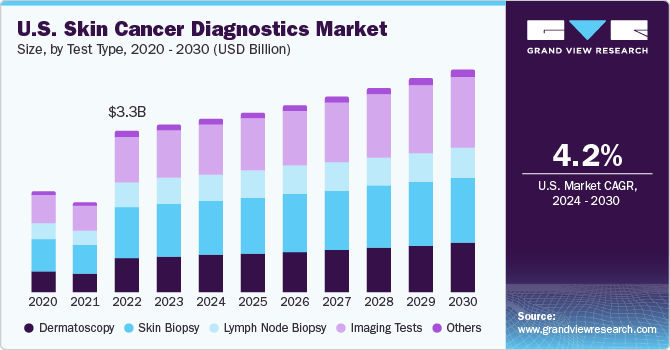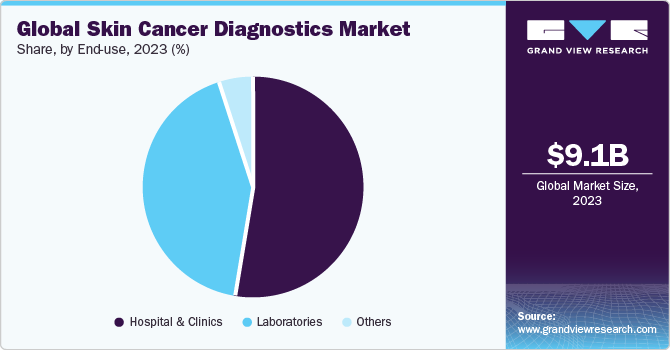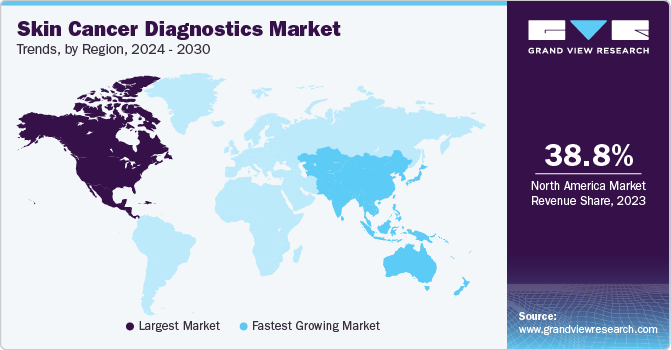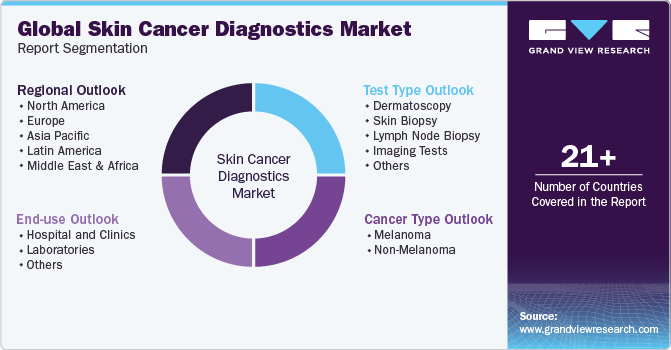- Home
- »
- Clinical Diagnostics
- »
-
Skin Cancer Diagnostics Market Size & Share Report, 2030GVR Report cover
![Skin Cancer Diagnostics Market Size, Share & Trends Report]()
Skin Cancer Diagnostics Market Size, Share & Trends Analysis Report By Cancer Type (Melanoma, Non-Melanoma), By Test Type (Dermatoscopy, Skin Biopsy, Lymph Node Biopsy), By End-use, By Region, And Segment Forecasts, 2024 - 2030
- Report ID: GVR-4-68040-322-6
- Number of Report Pages: 125
- Format: PDF, Horizon Databook
- Historical Range: 2018 - 2022
- Forecast Period: 2024 - 2030
- Industry: Healthcare
Skin Cancer Diagnostics Market Trends
The global skin cancer diagnostics market size was estimated at USD 9.14 billion in 2023 and is projected to grow at a CAGR of 5.52% from 2024 to 2030. The skin cancer diagnostics market is growing due to increased awareness about skin cancer, advancements in AI-based diagnostic tools, and initiatives promoting early detection. Rising skin cancer incidence, particularly in sun-exposed regions, and technological innovations, such as teledermatology, are expected to drive the market. Partnerships between healthcare providers and tech companies further support this growth by enhancing accessibility and accuracy of diagnoses.

Modern machine learning techniques rely on extensive datasets to identify patterns useful for classification, with diagnostic imaging being a particularly promising area for AI research. Skin cancer detection, in particular, is an attractive test type for AI due to the subjective nature of clinical and dermoscopic image interpretation. AI-assisted diagnosis offers several advantages, including improved access to specialist expertise, which is often scarce in many regions, leading to long waiting times for specialist appointments. There is growing optimism that AI-based systems could offer greater consistency and higher accuracy than human experts.
In dermatology, AI is applied across diverse tools for skin cancer detection, including Total Body Photography (TBP) and dermoscopy. Market-approved AI-powered software for dermatologists, such as MoleAnalyzer Pro (FotoFinder ATMB) and DEXI (Vectra WB360), is typically integrated with specialized hardware. These apps have undergone testing in retrospective and prospective trials, demonstrating their effectiveness. Moreover, AI has been applied to other noninvasive diagnostic techniques, such as Reflectance Confocal Microscopy (RCM) and Optical Coherence Tomography (OCT), reducing the number of unnecessary biopsies in skin cancer referral centers.
The field of dermato-oncology has seen significant advancements in noninvasive diagnostic tools, including dermoscopy, ultrasonography, confocal microscopy, and optical coherence tomography. These tools are crucial for diagnosing skin cancers, such as melanoma and Non-Melanoma Skin Cancers (NMSC), at earlier stages, as the incidence of these cancers continues to rise. Reflectance Confocal Microscopy (RCM) is a novel device used by the Skin Cancer Institute, offering noninvasive imaging of skin. This technology enables doctors to diagnose numerous cancers quickly and safely, without needing biopsy. Moreover, RCM allows physicians to monitor responses to treatment, making it a valuable tool in managing skin cancer patients.
Market Concentration & Characteristics
The skin cancer diagnostics field exhibits a high degree of innovation, integrating advanced technologies such as artificial intelligence and machine learning to enhance accuracy and early detection. Cutting-edge techniques such as digital dermoscopy, molecular diagnostics, and non-invasive imaging methods are transforming patient care. Innovations in biopsy methods and the development of novel biomarkers further contribute to earlier diagnosis and improved prognostic capabilities, significantly advancing the standard of skin cancer diagnostics.
The skin cancer diagnostics market has seen a high level of merger and acquisition activity, with companies seeking to expand their product portfolios and geographic presence. For instance, in May 2024 FotoFinder Systems, a global skin imaging solution provider, acquired DermLite, a renowned handheld dermatoscope supplier, marking a significant advancement in dermoscopy. This strategic merger is EMZ Partners’ first investment in the U.S. and a testament to its industry-leading innovations.

Regulations significantly impact the market by ensuring the accuracy and reliability of measurements and tests. The U.S. FDA expanded and finalized 510(k) registration routes for the safety and performance of medical devices. The expansion, based on the abbreviated form of 510(k), was drafted in 2018. The improved market approval pathway is focused on analyzing & assessing performance issues and device safety by demonstrating substantial equivalence.
In the skin cancer diagnostics market, product substitutes are limited. In skin cancer diagnostics, there are no true substitutes for biopsy, which remains the gold standard for definitive diagnosis. Despite advancements in non-invasive imaging and molecular techniques, biopsies provide unparalleled accuracy in identifying malignancies, making them an irreplaceable component of effective skin cancer diagnosis and treatment planning.
End-user concentration in skin cancer diagnostics is high, primarily involving dermatologists, oncologists, and specialized skin cancer clinics. These professionals rely heavily on diagnostic tools like dermoscopy, biopsies, and advanced imaging techniques to accurately diagnose and manage cancer, ensuring targeted treatment and improved patient outcomes. Their expertise is critical in early detection and intervention.
Cancer Type Insights
On the basis of cancer type, the nonmelanoma segment held the largest market share of 74.6% in 2023. The rising incidence of Nonmelanoma Skin Cancer (NMSC) represents a significant market driver for novel technologies in screening and diagnosis. Basal Cell Carcinoma (BCC) and Squamous Cell Carcinoma (SCC), which constitute 70% and 25% of NMSC cases, respectively, are the most prevalent forms of skin cancer, comprising 90% of all malignant skin tumors. Studies indicate a continued increase in NMSC cases until at least 2040, highlighting the urgent need for reliable screening tools.
In addition, deep learning, a form of AI, shows promise in image analysis and is particularly attractive for NMSC diagnosis. As NMSC cases increase globally, there is a growing demand for early detection tools. Deep learning has emerged as a valuable decision-support tool in medicine, offering significant potential in image analysis, a critical aspect of dermatology diagnoses. Dermatology heavily relies on visual diagnoses, making deep learning’s image analysis capabilities highly relevant for diagnosing skin cancer. With the widespread availability of smartphones equipped with powerful cameras, deep learning technology can also be leveraged for remote skin cancer screening test types. Current data indicates that deep learning technology for detecting and diagnosing cancer offers sensitivity & specificity comparable to trained dermatologists. While there is ongoing work to increase the clinical use of AI-based tools, the positive attitude of patients and physicians toward these technologies suggest that deep learning could be effectively integrated as a clinical decision-making tool.
Test Type Insights
Skin biopsy led the skin cancer diagnostics market with a market share of 31.66% in 2023. Skin biopsy is a fundamental diagnostic procedure in dermatology, with various methods available for different situations. Factors such as lesion type, location, and suspected diagnosis influence the choice of biopsy technique. Histopathologic evaluation remains the gold standard for diagnosing skin cancer, providing crucial information for treatment planning and prognosis.
The imaging tests segment is expected to grow at the fastest CAGR during the forecast period. . Emerging optical imaging modalities, including Reflectance Confocal Microscopy (RCM), Optical Coherence Tomography (OCT), Magnetic Resonance Imaging (MRI), Near-infrared (NIR) bioimaging, and Positron Emission Tomography (PET), offer noninvasive imaging data that can aid in the early detection of cutaneous tumors & assist in surgical planning. These modalities are valuable for observing dynamic processes, such as blood flow, immune cell activation, and tumor energy metabolism, which are relevant for disease progression.
End-use Insights
Hospitals and clinics led the skin cancer diagnostics market with a market share of 53.27% in 2023. In addition, it is expected to be the fastest-growing segment over the forecast period. Its growth can be attributed to the increasing incidence of skin cancer, advancements in diagnostic technologies, and rising awareness about early detection. The integration of AI and teledermatology in hospitals can further enhance diagnostic accuracy & accessibility, boosting the demand for hospital-based skin cancer diagnostic services.
In May 2023, the UK NHS planned to accelerate the rollout of teledermatology, which involves taking high-resolution images of skin spots, moles, or lesions for faster diagnosis and treatment of skin cancer. This technology uses a small lens attached to a phone camera (dermatoscope), which allows dermatologists to double the number of patients they can review daily. Teledermatology, currently used in about 15% of trusts offering dermatology services, was expected to be available in all areas by July 2023. It would also be expanded to GP practices, aiding people in rural areas and reducing the need for specialist appointments. More than 600,000 people were referred for skin cancer checks last year, a 9% increase from the previous year.

NHS trusts are expanding the use of teledermatology in community diagnostic centers to reduce waiting times. Patients can be referred directly to a local diagnostic hub, avoiding the need for a face-to-face appointment. In addition, magnifying lenses using AI technology are being trialed to assess lesions quickly and accurately. This technology has helped avoid around 10,000 unnecessary face-to-face appointments. In addition, it has enabled some hospitals to diagnose and treat virtually all skin cancer patients within 2 months of GP referral. The NHS's focus on technology-driven advancements in cancer diagnosis & treatment is expected to significantly improve patient outcomes and reduce the burden on healthcare resources.
Regional Insights
North America skin cancer diagnostics market accounted for 38.79% share in 2023. Skin cancer is the most prevalent form of cancer in the U.S.; approximately one in five U.S. individuals are expected to suffer from skin cancer in their lifetime. An estimated 9,500 individuals in the U.S. receive a skin cancer diagnosis daily. NMSC, including BCC and SCC, affects over 3 million U.S. citizens annually. In addition, strategic initiatives undertaken by key market players can offer lucrative opportunities for market growth over the forecast period. In May 2024, Epredia, a subsidiary of PHC Holdings Corporation, partnered with NovaScan, Inc. to sign a letter of intent for an exclusive commercial distribution agreement in the U.S. for MarginScan. This medical device is designed to aid physicians in the real-time detection of NMSC, as these companies drive innovation and provide a wide range of products to meet market demand.

U.S. Skin Cancer Diagnostics Market Trends
The skin cancer diagnostics market in the U.S. is expected to grow over the forecast period due to increasing prevalence of skin cancer. In the U.S., skin cancer is the most prevalent form of cancer, with approximately one in five Americans expected to develop it during their lifetime. Each day, an estimated 9,500 individuals in the U.S. receive a skin cancer diagnosis. Nonmelanoma Skin Cancer (NMSC), including Basal Cell Carcinoma (BCC) and Squamous Cell Carcinoma (SCC), affects over 3 million Americans annually.
Europe Skin Cancer Diagnostics Market Trends
Europe skin cancer diagnostics market was identified as a lucrative region in this industry. The skin cancer diagnostics market in the EU-27 countries is expected to observe continued growth due to the increasing incidence of melanoma. Several key players operate in this market, offering a range of diagnostic tests and services. For example, Roche Diagnostics provides cobas 4800 BRAF V600 Mutation Test, which is used to detect mutations in the BRAF gene, commonly found in melanoma. Another example is Siemens Healthineers, which offers the ADVIA Centaur BRAF V600 Mutation Test for the detection of BRAF mutations.
The skin cancer diagnostics market in the UK is expected to grow over the forecast period. Skin cancer cases in the UK have surged to record levels, with approximately 17,500 cases diagnosed annually. Projections suggest that these numbers could rise by about 50% over the next two decades. In 2024, to address this growing concern, innovative research led by Dr. David Bajek, in collaboration with the University and NHS Tayside, aims to reduce the need for biopsy surgeries to detect and treat skin cancer. The National Health Service (NHS) in the UK is backing this effort by funding nine trusts to pilot Skin Analytics' AI device for detecting cancerous lesions.
The France skin cancer diagnostics market is expected to grow over the forecast period attributed to the increasing focus on research and development in skin cancer diagnostics.
The skin cancer diagnostics market in Germany is expected to grow over the forecast period due to the increasing adoption of advanced diagnostic techniques.
Asia Pacific Skin Cancer Diagnostics Market Trends
The Asia Pacific is anticipated to witness fastest growth in the skin cancer diagnostics market, driven by increasing awareness of skin cancer, rising incidences due to environmental factors such as UV exposure, and advancements in diagnostic technologies. Growing healthcare expenditure and improved access to medical facilities also contribute to market growth, along with government initiatives promoting early detection and treatment of skin cancer.
The skin cancer diagnostics market in China is expected to grow over the forecast period due the growing focus on improving healthcare R&D aided with development of novel technologies.
The Japan skin cancer diagnostics market is expected to grow over the forecast period due to the presence of well-established healthcare system.
Latin America Skin Cancer Diagnostics Market Trends
The Latin America skin cancer diagnostics market was identified as a lucrative region in this industry. Technological advancements in the region is anticipated to fuel market growth.
The skin cancer diagnostics market in Brazil is expected to grow over the forecast period due to the increasing prevalence of skin cancer. Skin cancer is the most common type of cancer, accounting for 25% of all cancer cases in the country.
Middle East And Africa Skin Cancer Diagnostics Market Trends
The Middle East and Africa (MEA) is witnessing steady growth due to several factors such as increasing incidence of skin cancer, rising awareness about early detection, advancements in diagnostic technologies, and growing initiatives for skin cancer prevention & control.
The market for skin cancer diagnostics in South Arabia is influenced by various factors, including technological advancements, increasing awareness about skin cancer, and the rapidly aging population. The field of dermatology and oncology has witnessed significant technological advancements in diagnostic tools and techniques for detecting skin cancer at early stages.
Key Skin Cancer Diagnostics Company Insights
Some of the leading players operating in the skin cancer diagnostics market include bioMérieux, Inc., FOUNDATION MEDICINE, INC., DermaSensor, Inc., F. Hoffmann-La Roche Ltd, NeoGenomics Laboratories, Quest Diagnostics Incorporated. Key players are using existing customer bases in the region to prioritize maintaining high-quality standards and gain high market size access. This strategy is useful for brands that have already built trust in the market. These players are heavily investing in advanced technology and infrastructure, allowing them to process & analyze a large volume of samples efficiently. Moreover, companies undertake various strategic initiatives with other companies and distributors to strengthen their market presence.
DermTech, Castle Biosciences, and SkinVision are some of the emerging market participants in the skin cancer diagnostics market. These companies focus on achieving funding support from government bodies and healthcare organizations aided with novel product launches to capitalize on untapped avenues.
Key Skin Cancer Diagnostics Companies:
The following are the leading companies in the skin cancer diagnostics market. These companies collectively hold the largest market share and dictate industry trends.
- Castle Bioscience
- DermTech
- bioMérieux Inc.
- FOUNDATION MEDICINE, INC.
- DermaSensor, Inc.
- F Hoffmann-La Roche Ltd
- NeoGenomics Laboratories
- Quest Diagnostics Incorporated.
- SkylineDx
- Abbott
Recent Developments
-
In February 2024, Quest Diagnostics launched MelaNodal Predict, a highly advanced predictive gene expression test to help personalize treatment decisions for patients with melanoma, the deadliest form of skin cancer and one of the most common cancers in the U.S.
-
In January 2024, DermaSensor Inc. received FDA clearance for its noninvasive skin cancer assessment system, which uses artificial intelligence to detect common skin cancers, such as melanoma, basal cell carcinoma, and SCC. The wireless, handheld device provides instant, objective results using an FDA-approved algorithm, allowing physicians to evaluate suspicious lesions without invasive procedures.
-
In January 2024, SkylineDx, a diagnostics technology developer, received European Patent No. 3827101, a significant advancement in cancer diagnostics and personalized treatment. The patent outlines novel methods for categorizing and managing patients with primary cutaneous melanoma, using gene expression signature levels.
Skin Cancer Diagnostics Market Report Scope
Report Attribute
Details
Market size value in 2024
USD 9.58 billion
Revenue forecast in 2030
USD 13.23 billion
Growth rate
CAGR of 5.52% from 2024 to 2030
Actual data
2018 - 2022
Forecast period
2024 - 2030
Quantitative units
Revenue in USD million and CAGR from 2024 to 2030
Report coverage
Revenue forecast, company ranking, competitive landscape, growth factors, and trends
Segments covered
Cancer type, test type, end-use, region
Regional scope
North America; Europe; Asia Pacific; Latin America; MEA
Country scope
U.S.; Canada; Germany; UK; France; Italy; Spain; Denmark; Sweden; Norway; China; Japan; India; South Korea; Australia; Brazil Mexico; Argentina; South Africa; UAE; Kuwait; Saudi Arabia
Key companies profiled
Castle Bioscience; DermTech; bioMérieux , Inc.; FOUNDATION MEDICINE, INC.; DermaSensor, Inc.; F . Hoffmann-La Roche Ltd; NeoGenomics Laboratories; Quest Diagnostics Incorporated.; SkylineDx, Abbott
Customization scope
Free report customization (equivalent up to 8 analysts working days) with purchase. Addition or alteration to country, regional & segment scope.
Pricing and purchase options
Avail customized purchase options to meet your exact research needs. Explore purchase options
Global Skin Cancer Diagnostics Market Report Segmentation
This report forecasts revenue growth at global, regional, and country levels and provides an analysis of the latest industry trends in each of the sub-segments from 2018 to 2030. For this study, Grand View Research has segmented the global skin cancer diagnostics market report based on cancer type, test type, end-use, and region.

-
Cancer Type Outlook (Revenue, USD Million, 2018 - 2030)
-
Melanoma
-
Non-Melanoma
-
-
Test Type Outlook (Revenue, USD Million, 2018 - 2030)
-
Dermatoscopy
-
Skin Biopsy
-
Lymph Node Biopsy
-
Imaging Tests
-
Others
-
-
End-use Outlook (Revenue, USD Million, 2018 - 2030)
-
Hospital and Clinics
-
Laboratories
-
Others
-
-
Regional Outlook (Revenue, USD Million, 2018 - 2030)
-
North America
-
U.S.
-
Canada
-
-
Europe
-
Germany
-
UK
-
France
-
Italy
-
Spain
-
Denmark
-
Sweden
-
Norway
-
-
Asia Pacific
-
China
-
Japan
-
India
-
South Korea
-
Australia
-
Thailand
-
-
Latin America
-
Brazil
-
Mexico
-
Argentina
-
-
Middle East and Africa (MEA)
-
South Africa
-
Saudi Arabia
-
Kuwait
-
UAE
-
-
Frequently Asked Questions About This Report
b. The global skin cancer diagnostics market size was estimated at USD 9.14 billion in 2023 and is expected to reach USD 9.58 billion in 2024.
b. The global skin cancer diagnostics market is expected to grow at a compound annual growth rate of 5.5% from 2024 to 2030 to reach USD 13.23 billion by 2030.
b. North America dominated the skin cancer diagnostics market with a share of 38.79% in 2023. This is attributable to increasing prevalence of skin cancer in the region
b. Some key players operating in the skin cancer diagnostics market include Castle Bioscience, DermTech, bioMérieux, Inc., FOUNDATION MEDICINE, INC., DermaSensor, Inc., F. Hoffmann-La Roche Ltd, NeoGenomics Laboratories, Quest Diagnostics Incorporated., SkylineDx and Abbott
b. Key factors that are driving the market growth are increased awareness about skin cancer, advancements in AI-based diagnostic tools, and initiatives promoting early detection. Rising skin cancer incidence, particularly in sun-exposed regions, and technological innovations, such as teledermatology, are expected to drive the market. Partnerships between healthcare providers and tech companies further support this growth by enhancing accessibility and accuracy of diagnoses.
Share this report with your colleague or friend.
![gvr icn]()
NEED A CUSTOM REPORT?
We can customize every report - free of charge - including purchasing stand-alone sections or country-level reports, as well as offer affordable discounts for start-ups & universities. Contact us now
![Certified Icon]()
We are GDPR and CCPA compliant! Your transaction & personal information is safe and secure. For more details, please read our privacy policy.
We are committed towards customer satisfaction, and quality service.
"The quality of research they have done for us has been excellent."





